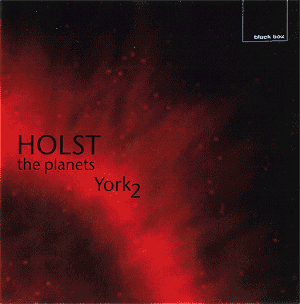The first fifteen minutes of this disc constitute the
Complete Works of Gustav Holst for solo piano. These may be tiny chippings
from the masterís workshop yet they all reflect his astringent originality.
They are not all that easy to bring off; "O! I hae seen the roses
blaw", for instance, starts off like a dead simple Grade One arrangement
(though a first year student might find the harmonies a bit odd) and
then wraps the tune around first with decorative running passages and
then with typical chords based on fourths. None of these decorations
seem to have much to do with the theme itself and if they are not kept
well separated both tonally and dynamically the piece can just sound
a mess. The present performance makes excellent sense of it.
It is possible to feel that both the Toccata and "Chrissemas
Day", lively as they are, have their most interesting moments near
the beginning, something that can hardly be said of "The Shoemakker"
which is over in 40 seconds.
The Nocturne and Jig were the result of a request from
Holstís daughter Imogen for some piano pieces that were not based on
folksongs. The Nocturne is extremely effective and rewarding, both for
the pianist (it is real pianistic writing) and the listener (it has
atmosphere but also contrast). The Jig has always seemed to me a rather
grey and dogmatic bit of fugal writing and the performance does not
convince me otherwise.
We are not told which of the two pianists plays but
in both the Toccata and the Jig I detect a tendency to rush ahead impetuously,
keeping textures none too clean, where cool headed clarity is surely
the order of the day. The other three folksong pieces are excellent
from this point of view so I suppose that one pianist plays the Toccata,
Nocturne and Jig while the other plays the rest, and one is more suited
to the music than the other. But I donít want to make too much of this;
if you want to get to know Holstís piano music this is a good-to-excellent
guide.
The "filler", or the "main work"
(whichever way you look at it) is the first recording of a piano-duet
arrangement of "The Planets" made by two of Holstís assistants,
Vally Lasker and Nora Day. As a way of getting hands-on experience of
the music I can think of nothing better and I am surprised it has not
been disseminated more widely, since I am sure most music students would
enjoy "having a go". As an alternative listening experience,
well, some parts work better than others. The sheer modernity of Mars
certainly strikes one anew, while elsewhere the influence of Debussy
is more evident than it is when garbed in Holstís not very Debussian
orchestral colours. This also has the effect of reducing the music in
scale, Venus and Mercury emerging as pastel-coloured little character-pieces.
Jupiter is surprisingly ineffective, the outer sections jaunty but again
reduced in scale, and "the" tune no more effective than the
average classroom rendering as a hymn. As for Saturn and Neptune, the
lack of sustained sounds makes these only intermittently convincing
and even raises doubts as to how much actual music these pieces contain
without an orchestra to flesh it out.
Any difference in style noted between the two pianists
does not seem to affect them when they work together and their unanimity
of purpose is beyond praise. It is interesting that the performance
often seemed to be slower than one usually hears on the orchestra, but
a glance at the timings of Boultís fourth (New Philharmonia) recording
reveals that they are slower only in Mars and Neptune, and not to any
great degree, while in all other movement Boultís timings are longer,
often startlingly so. Saturn, for instance, takes him 9í 09" compared
with the Yorksí 7í 36" Ė and even so the piano cannot really sustain
it.
I must say I found this quite instructive to hear once,
mentally comparing it with the well-known orchestral sounds. But whatever
would anyone make of it who heard it without knowing the orchestral
version? Well, one person who heard this version before he, or anybody
else, had heard an orchestral performance was a young man called Adrian
Boult, who later recalled hearing Misses Lasker and Day play it in 1917.
And the rest is history. (Oddly, the notes date the arrangement 1932
but I trust Sir Adrianís memory; was it maybe revised in 1932?).
Christopher Howell
